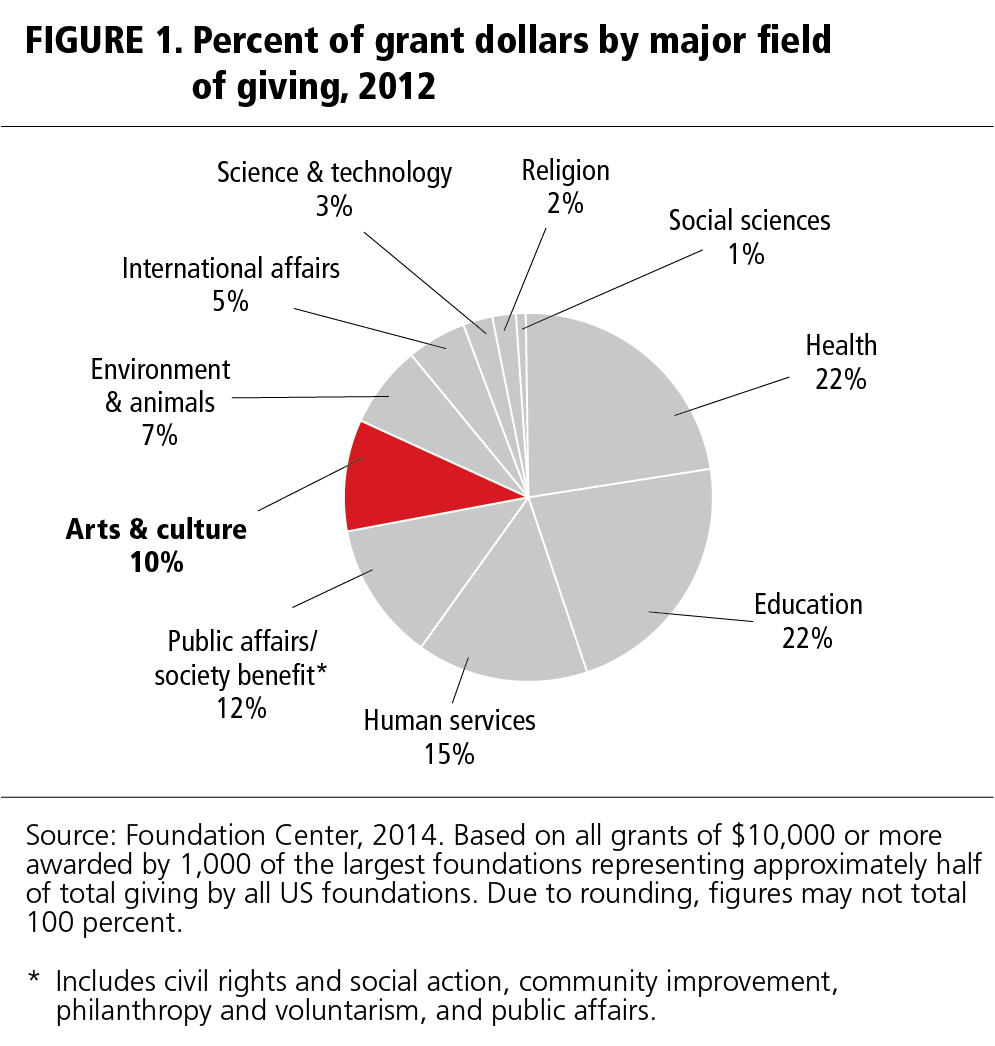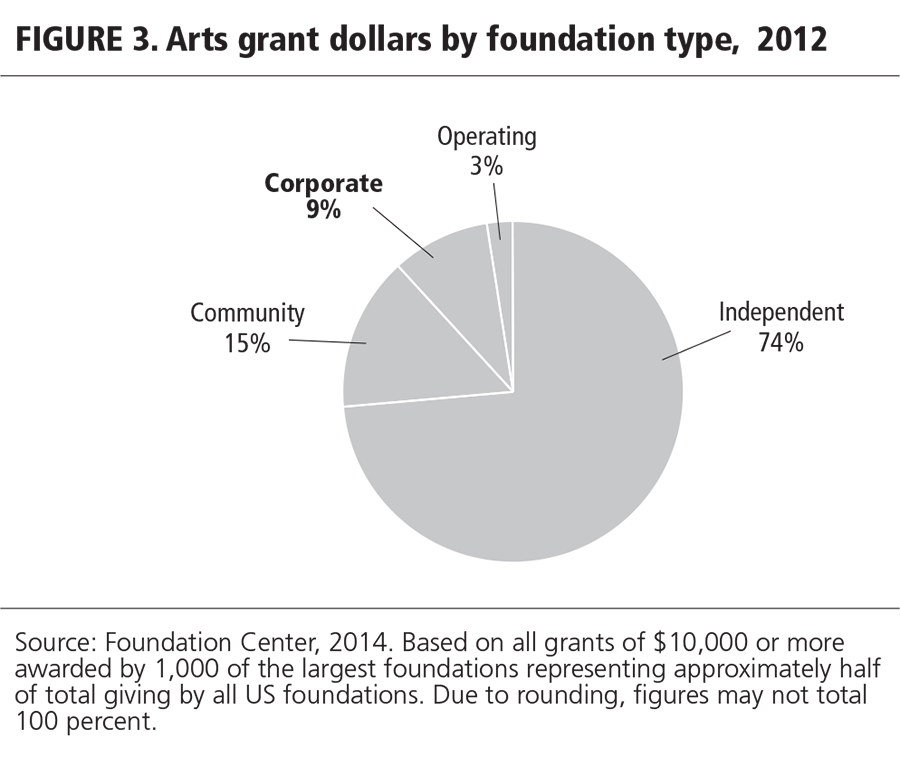Foundation Grants to Arts and Culture, 2012
A One-year Snapshot
Download:
![]() Arts Funding Snapshot: GIA’s Annual Research on Support for Arts and Culture (3 Mb)
Arts Funding Snapshot: GIA’s Annual Research on Support for Arts and Culture (3 Mb)
Overall US foundation giving reached nearly $52 billion in 2012. After adjusting for inflation, foundation support surpassed slightly the previous peak level of giving reported in 2008. Driven by strong stock market returns and a continuing, albeit inconsistent, economic recovery, foundation funding showed consecutive years of positive gains following the worst economic downturn since the Great Depression.
What remains unclear is how foundation funding for the arts is faring. Among the 1,000 largest US foundations, arts and culture accounted for an unchanged 10 percent of grant dollars between 2011 and 2012. While this consistency is encouraging, the share remained below the roughly 11 to 12 percent share recorded over much of the prior decade. Actual arts grant dollars are likely to grow along with overall foundation giving. But the next several years will tell whether arts funding rebounds to its earlier share of overall foundation support or settles in at a lower level.
Highlights
Foundation Center offers these key findings from GIA’s thirteenth snapshot of foundation giving to arts and culture. The definition of arts and culture used for this snapshot is based on the National Taxonomy of Exempt Entities and encompasses funding for the performing arts, museums, visual arts, multidisciplinary arts, media and communications, humanities, and historical preservation. Most importantly, the findings tell us about the changes in foundation giving for the arts between 2011 and 2012 by a matched set of 714 funders and the distribution of 2012 arts and culture giving by the 1,000 largest US foundations by total giving.1 They are based on all arts grants of $10,000 or more reported to Foundation Center by these sets of the largest US foundations, hereafter referred to as “the sample”.2 The Center has conducted annual examinations of the giving patterns of the nation’s largest foundations for close to four decades.
Arts funding as a share of total dollars remained steady in the full 2012 grants sample. Among the 1,000 largest foundations included in the full grants sample for 2012, arts giving totaled $2.2 billion, or 10 percent of overall grant dollars. This share remained unchanged compared to the share captured by the arts in 2011. Similarly, the share of number of arts grants — which is not affected by fluctuations in the size of grants — remained basically unchanged at 13.5 percent.
A reduction in arts funding by a matched subset of leading funders was balanced out by other grantmakers. Of the 1,000 foundations included in Foundation Center’s grants samples for 2011 and 2012, a total of 714 funders were in both sets. Variations in the composition of the grants sample from year to year may mask broader trends, and an examination of changes in arts giving among this subset of foundations showed that their arts grant dollars declined 5 percent. Nonetheless, this reduction in giving by the matched set of funders was largely balanced out by a higher level of giving among the 286 other foundations included in the 2012 sample, compared to the 286 non-matched foundations included in the 2011 sample.
The size of the median arts grant remained unchanged. The median arts and culture grant size — $25,000 — did not change from 2011 to 2012, although the real value of the median grant decreased due to inflation. The unadjusted value was below the $30,000 median amount for all foundation grants in the latest year and has not changed since 1993.
Large grants account for more than half of arts grant dollars. Large arts grants of $500,000 and more captured 52.2 percent of total grant dollars for the arts in the 2012 sample, down from 57 percent in 2011.
Relative to most other fields, a larger share of arts grant dollars provided operating support. In 2012, general operating support accounted for 31.2 percent of arts and culture grant dollars. By comparison, just 13 percent of arts grant dollars in 1989 provided operating support.
Top arts funders accounted for a larger share of overall giving. The top 25 arts funders by giving amount provided 33.7 percent of total foundation arts dollars in 2012, down from 37.3 percent in 2011. The share of arts giving accounted for by the top funders remains well below the more than 50 percent shares recorded in the early 1980s.
Please note
It is important to keep in mind that the foundation grantmaking examined here represents only one source of arts financing. It does not examine arts support from earned income, governments, individual donors, or the business community. This analysis also looks only at foundation arts support for nonprofit organizations, and not for individual artists, commercial arts enterprises, or informal and unincorporated activities. In addition, the analysis of changes in giving between 2011 and 2012 is based on a matched subset of 714 funders, while statistics on the distribution of funding and actual dollar amounts and numbers of grants are based on the full set of 1,000 grantmakers included in Foundation Center’s 2012 FC 1000 grants sample.
Specific Findings
Overall foundation dollars for the arts. The 1,000 largest foundations by total giving included in Foundation Center’s full 2012 sample awarded 20,412 arts and culture grants totaling $2.2 billion, or 10 percent of overall grant dollars (figure 1). This share was consistent with 2011. By comparison, the share of number of arts grants remained nearly unchanged at 13.5 percent. Among a matched subset of 714 foundations in the sample, giving for the arts declined. Between 2011 and 2012, it decreased 5 percent, compared to a 10.3 percent reduction in grant dollars overall. Among the nine other major subject areas tracked by the Center, four areas registered a decline in funding, while five areas reported increases. Health, human services, the social sciences, and education all reported decreases in grant dollars, while international affairs, science and technology, the environment, public affairs, and religion showed increases (figure 2).
The impact of exceptionally large grants. Every year and in all funding areas, a few very large grants can skew overall totals, creating distortions in long-term grantmaking trends. In 2012, nine arts and culture grants provided at least $10 million, and instances where these grants had a notable impact on grantmaking patterns are identified throughout this analysis. Yet despite the potential fluctuations caused by these exceptional grants, Foundation Center data in all fields have always included them, providing consistency over time. (In addition, Foundation Center provides statistics based on share of number of grants, which are not skewed by exceptionally large grants.)
Corporate foundations represent an important source of support for arts and culture. While corporate foundations account for less than 4 percent of US private and community foundations, the larger corporate foundations included in the 2012 grants sample provided 9.2 percent of grant dollars for the arts (figure 3). Actual grant dollars totaled $197.6 million. By number, corporate foundations allocated 3,795 grants, or 18.6 percent of the overall number of arts grants in 2012.
Grants by arts subfield
Funding for the performing arts accounted for over one-third (35.2 percent) of all foundation arts dollars in 2012 (figure 4), surpassing the share reported for museums (30.3 percent). From the start of the 1980s until 1997, the performing arts consistently received more foundation support than museums. However, museums have surpassed the performing arts by share in several recent years (1998, 1999, 2001, 2004, 2005, 2008, and 2009). More study would be needed to adequately understand the underlying reasons for the shifts in share between these two fields of activity, for example, the entry onto the scene of new and large arts funders, extraordinarily large grants, the contribution of valuable art collections, and new capital projects at museums.
Giving to performing arts. In 2012, performing arts grant dollars declined 7.2 percent among the matched subset of 714 funders, while the number of grants rose 1.2 percent. A total of 8,265 grants were awarded for the performing arts by the overall set of 1,000 largest foundations — close to double the number reported for museums. In general, the average performing arts grant tends to be smaller in size than the average museum grant. The largest share of giving to the performing arts supported performing arts centers and theater, followed by symphony orchestras and opera. The biggest performing arts grant in the latest sample was an $18 million award from the Minnesota-based Robina Foundation to Yale University to endow the Binger Center for New Theater. Included within the performing arts is support for performing arts education, which totaled $37.6 million in 2012. (See “Giving to multidisciplinary arts” below for a figure on foundation grant dollars supporting other types of arts education.)
Giving to museums. In 2012, museums benefited from 4,206 grants totaling $653.5 million awarded by the 1,000 largest foundations included in the full grants sample. Among museum types, about half of funding (44.8 percent) supported art museums. Among the matched subset of 714 foundations, grant dollars allocated to museums declined 3.4 percent between 2011 and 2012, while the number of grants awarded was up 4.8 percent.
Giving to media and communications. Support for media and communications represented 10.1 percent of arts funding in 2012, down from 10.8 percent in 2011.3 Among the matched subset of funders, grant dollars for media and communications fell 10.4 percent in the latest year.
Giving to multidisciplinary arts. The share of arts giving for multidisciplinary arts increased to 9.6 percent in 2012.4 Among the matched subset of foundations, grant dollars awarded for multidisciplinary arts was also up 12.2 percent from 2011. Among the various subcategories of multidisciplinary arts, arts education (excluding performing arts education) totaled $49.9 million in the latest year.
Giving to historic preservation. Support for historic preservation increased 7.4 percent between 2011 and 2012 among the matched subset of funders. The number of grants awarded was also up 9 percent. Within the full set of the top 1,000 grantmakers, historic preservation benefited from $103.7 million in 2012.
Giving to the humanities. Funding for the humanities accounted for 4.7 percent of arts grant dollars in 2012, down slightly from the 5.2 percent share captured in 2011.5 Overall dollars totaled $102.2 million. Among the matched subset of funders, grant dollars for the humanities fell 13.6 percent, although the number of grants awarded was down just 1 percent. Included within the humanities is funding for art history, history and archaeology, classical and foreign languages, linguistics, literature, philosophy, and theology.
Giving to the visual arts. Among the matched subset of 714 foundations, grant dollars for the visual arts and architecture decreased 8.1 percent between 2011 and 2012, although the number of grants for the field was virtually unchanged. Within the full set of grantmakers, the visual arts and architecture benefited from $89.5 million in 2012, up from $72 million in 2011.
Grants by types of support
An important caveat to report on the allocation of foundation dollars by specific types of support is that for roughly 19 percent of arts grant dollars in the 2012 Foundation Center sample, the type of support could not be identified. This means that modest differences in percentages — that is, variations under 10 percent — may not be reliable. (The grant records available to Foundation Center often lack the information necessary to identify the type of support. For example, it is often the case that the only source of data on grants is the 990-PF tax return, and this tends to be less complete than other forms of grant reporting.)
The arts compared to other foundation fields of giving. The three largest categories of support tracked by Foundation Center are program support, general operating support, and capital support. Of these, special programs and projects typically receive the largest share of arts and culture grant dollars and grants. In fact, the same is true in most of the major fields, such as health and education, where program support consistently accounts for the largest share of funding.
General operating support accounted for the second largest share of arts grant dollars in 2012. The shares of grant dollars and number of grants allocated for this type of support in 2012 were higher for arts and culture (31.2 percent and 38.5 percent, respectively) than for all other fields. Moreover, the portion of grant dollars allocated to this type of support is markedly higher than it was in the past. For example, operating support represented only 13 percent of arts funding in 1989.
Capital support captured 18.4 percent of the share of arts grant dollars in 2012, down from 22.7 percent in 2011. The share of grant dollars allocated for this type of support was higher for arts and culture than for all but two other fields (international affairs and science and technology). Grants for capital support are larger on average than awards for program and general operating support, and exceptionally large capital grants can have a pronounced effect on the distribution of funding by type of support. In fact, arts dollars allocated to capital support have fluctuated more than arts dollars to the other two primary categories of support: in 1986 the share allocated to capital was about 44 percent; in 1993 it was about 30 percent; and in 1999 it was about 41 percent. (In general, the share of capital support is highest in periods of strong foundation asset growth.)
Arts grants by specific types of support. Table 1 provides a breakdown of more specific types of support within the larger support categories and lists both the specific dollar value and number of grants made in each type. As with all data in the “Snapshot,” it is important to keep in mind that this table includes only grants of $10,000 or more awarded to organizations by a sample of the top 1,000 foundations by total giving. It is also important to note that approximately 19 percent of the arts grant dollars in this sample were not specified for a type of support.
Grants by grant size
Median grant size. The median or “typical” grant amount for arts and culture in 2012 was $25,000, which was below the median amount for all foundation grants ($30,000).6 This amount has remained unchanged since 1993. More study would be required to determine whether the unchanged median means that foundation arts grants simply are not keeping pace with inflation, or whether, in combination with the increased number of grants, it means that foundations are choosing to distribute funds more broadly to a larger number of recipients.
Small and midsized grants. Roughly two-thirds (65 percent) of all arts grants in the 2012 sample were for amounts between $10,000 and $49,999 (table 2), nearly unchanged from the 2011 share. The share of midsized arts grants ($50,000 to $499,999) also remained fairly consistent at about 31 percent.
Large grants. The share of larger arts grants ($500,000 and over) decreased slightly to 3.9 percent of the total number of arts grants in 2012, compared to 4.2 percent in 2011. Their share of total grant dollars also declined to 52.2 percent, compared to 57.3 percent in 2011. Overall, foundations in the sample made 92 arts grants of at least $2.5 million in 2012, down from 112 in 2011.
In addition to the $18 million award from the Minnesota-based Robina Foundation to Yale University to endow the Binger Center for New Theater (noted earlier), examples of other especially large grants in the 2012 set included the Freedom Forum’s $26.6 million continuing operating support grant to the Newseum (DC); the Edward C. Johnson Fund’s $12.1 million award to the Brookfield Arts Foundation (MA) for art acquisition; and the David H. Koch Charitable Foundation’s $10 million grants to the City Center of Music and Drama (NY) for renovations to New York State Theatre Building.
The twenty-five largest arts funders. The top twenty-five arts funders by giving amount provided 33.7 percent of the total arts dollars in Foundation Center’s 2012 sample (table 3), down from 37.3 percent in 2011. Overall, the share of giving accounted for by the top twenty-five arts funders has fluctuated between 33 and 39 percent since the end of the 1990s. By comparison, in the early 1980s, the top twenty-five arts funders accounted for more than half of the grant dollars in the sample. This suggests that the base of large arts funders has widened since that time, making arts funding less concentrated among a small number of foundations.
Top foundations by share of arts giving out of overall giving. Of the foundations that committed large percentages of their grant dollars to arts and culture, many are the smaller foundations in the sample (table 4). Among the top 100 foundations ranked by share of arts giving out of total giving, over half of foundations (61) gave less than $5 million in total arts grant dollars in 2012.
Giving for international cultural exchange
Grant dollars supporting international cultural exchange increased 67.7 percent between 2011 and 2012 among the matched subset of 714 funders. This follows three consecutive annual decreases of funding for this area tracked by Foundation Center. Within the full 2012 grants set, foundations made 188 grants related to international cultural exchange totaling $30.6 million. The largest award was a $10.8 million grant from the Ford Foundation to the Institute of International Education for Global Travel and Learning Fund to administer travel awards and other program-related learning activities. By comparison, the largest grant reported in 2011 for international cultural exchange was a $1.7 million grant from the Houston Endowment to the Asia Society Texas Center for transitional support for its new facility.
Notes
- Over time, the sample size has changed, which could also distort year-to-year fluctuations in grant dollars and grants targeting specific activities or populations. To account for these potential distortions year to year, Foundation Center has analyzed changes in giving based on a matched set of funders.
- Source of the data. This analysis is based on the Foundation Center’s 2012 FC 1000 set, which includes all of the grants of $10,000 or more reported by 1,000 of the largest US independent, corporate, community, and grantmaking operating foundations by total giving. For community foundations, the set includes only discretionary grants and donor-advised grants (when provided by the funder). The set excludes grants to individuals. This set accounts for approximately half of giving by all of the more than 86,000 active US grantmaking foundations. Grant amounts may represent the full authorized amount of the grant or the amount paid in that year, depending upon the information made available by each foundation. Grant records included in the set were reported to the Foundation Center between June 2013 and May 2014. Most foundations are represented with 2012 grants data and a few with 2011 grants data, if more current data were not available in time for inclusion in the set.
- Includes support for the production and dissemination of one or more media forms including film/video, television, radio, and print publishing; and support for journalism and communications centers.
- Includes support for multidisciplinary centers, ethnic/folk arts, arts education, and arts councils. For a detailed analysis of foundation funding for arts education, see L. Renz and J. Atienza, Foundation Funding for Arts Education (New York: Foundation Center, 2005).
- Includes support for archaeology, art history, modern and classical languages, philosophy, ethics, theology, and comparative religion.
- The median — meaning that half of the grants are above and half are below the amount — is generally acknowledged to be a more representative measure of the typical grant than the mean or “average,” because the median is not influenced by extreme high or low amounts.








